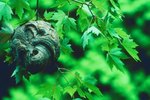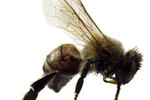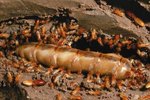
The only true hornets in North America aren't a native species. Also known as brown or giant hornets, European hornets (Vespa crabro germana) were introduced at New York just before the Civil War. Unlike bees, wasps and other stinging insects, European hornets are generally active at night. While it's advisable to eradicate wasps' nests at night, that's not the case with hornets.
European Hornet
While people often use the words wasp and hornet interchangeably, the two insect types are distinct. The mature European hornet measures about 1 inch in length. His head and thorax are reddish brown, while his abdomen has yellow and black markings, similar to a yellow jacket's. The European hornet also sports hairs on abdomen and thorax. Bees are generally smaller and hairier than hornets.
Hornets' Nests
European hornets prefer to create nests in tree cavities, but they will build nests around or inside buildings, especially under eaves or in attics. Nests consist of softwoods chewed to a pulp, resulting in material suitable for forming into shapes. The queen begins the nest, building only a few cells that she lays eggs in. As the eggs hatch, the queen provides insect prey for them to eat. Once the larvae mature, they become the workers; the queen just continues producing eggs. The average colony consists of between 200 and 400 insects.
Hornet Activity
Hornets are active throughout the day and much of the night. Since they're attracted to light, they're known to hit their bodies against windows, seeking the light indoors. These are the worker hornets -- infertile females whose jobs include building nests and finding food for hornet larvae. Workers perform their jobs constantly during the day and night, but they rest in the hours in the early morning hours before sunrise. They stir again in the morning, after the sun rises. Most active in summer, these workers die off as cold weather approaches.
Eradicating the Nest
Since hornets are most likely to be inside the nest in the early morning hours, that's the best time to destroy it. Don't use a flashlight or any other type of light to locate the nest opening if natural light is still dim -- your artificial light might invite a hornet attack. You must spray or otherwise apply an appropriate pesticide into the opening. It's best to hire a professional exterminator to eradicate a nest, since angry hornets can do some serious stinging. A Clemson University website recommends leaving nests alone if they aren't in an area puts humans at risk. All the inhabitants die off in the winter except for the pregnant queen. She spends the cold season in a protected area, perhaps underneath a rock or log. When spring arrives, nest creation starts anew.
References
Photo Credits
-
Jupiterimages/Photos.com/Getty Images
Writer Bio
Jane Meggitt has been a writer for more than 20 years. In addition to reporting for a major newspaper chain, she has been published in "Horse News," "Suburban Classic," "Hoof Beats," "Equine Journal" and other publications. She has a Bachelor of Arts in English from New York University and an Associate of Arts from the American Academy of Dramatics Arts, New York City.




